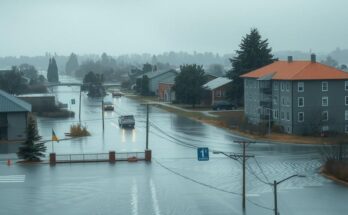Recently, severe thunderstorms have wreaked havoc across eastern Australia, leading to over 7,000 emergency incidents attended by the NSW SES. The storms resulted in numerous lightning strikes, fatalities, power outages, and significant property damage, with ongoing threats of floods and heatwaves. The increasing frequency and intensity of such weather events raise concerns regarding the adequacy of emergency services and the impact of climate change.
The New South Wales State Emergency Services (NSW SES) has attended over 7,000 storm-related incidents since Wednesday, as severe storms impacted eastern Australia. Forecasts indicate ongoing thunderstorms through the weekend, alongside a tropical cyclone near Western Australia, prompting alerts for gale force winds. Queensland and Western Australia are currently experiencing a significant heatwave.
Heavy rains along the New South Wales coast have led to various flood warnings. Residents of Ferndale Caravan Park were instructed to evacuate due to imminent flooding risks. The extreme weather originated from a cold front that created a storm line reaching from Queensland to Tasmania, spanning over 1,500 kilometers.
Tragically, an 80-year-old man died when a tree fell on his vehicle in Cowra, while four others were hurt in Wagga Wagga due to strong winds overturning a hut. Weatherzone reported nearly 1.8 million lightning strikes from Queensland to Tasmania in a 24-hour period. In Sydney alone, over 73,000 lightning strikes occurred within a 100 km radius, affecting power supply to approximately 200,000 homes.
Incidents of lightning also caused significant damage, including a hit on Crown Casino in Sydney that leaked rain into the building. The storm led to the destruction of homes, as roofs were torn off and families sought temporary housing. Additionally, wildfires ignited in Mudgee and Dubbo due to lightning strikes, further complicating emergency efforts.
The storms generated wind gusts exceeding 100 km/h, with the highest recorded at 120 km/h near Newcastle. Some regions experienced substantial rainfall, such as Eurobadalla, which saw 127 millimeters fall in just 24 hours, contributing to flash flooding. The NSW SES advised residents in multiple areas to remain indoors because of forecasted damaging winds and large hailstones.
Prior forecasts predicted a heatwave in New South Wales, but this was retracted as the cold front developed. The Bureau of Meteorology issued flood warnings affecting a 400 km area, advising campers to avoid riverbanks during the holidays. A report by the Commonwealth Scientific and Industrial Research Organisation noted Australia has already warmed by 1.5 degrees since 1910, with a significant increase in wet season rainfalls and extreme weather events.
The CSIRO’s report highlighted that climate change is leading to more frequent and intense rainfall events, compounded by extreme heat and prolonged droughts. Emergency services are ill-prepared for these escalating weather threats, primarily relying on a 10,000-strong volunteer workforce with only 500 full-time employees.
Current government policies remain disconnected from necessary climate change action, including the approval of new coal mines despite scientific consensus on fossil fuel impacts. Addressing these urgent climate issues requires a unified effort from the global working class to challenge the capitalist paradigms that perpetuate environmental degradation, aiming for a socialist transformation prioritizing human survival over corporate profit interests.
The article discusses the severe impact of recent storms in eastern Australia, particularly focusing on New South Wales (NSW) and the responses of emergency services to numerous incidents caused by extreme weather. It explains the ongoing threat of flooding, power outages, and the exacerbating conditions due to climate change and government policy actions regarding fossil fuels. These unprecedented conditions highlight the vulnerabilities of emergency services and the need for significant reforms in addressing climate-related disasters.
The current storms in eastern Australia illustrate the devastating consequences of extreme weather, exacerbated by climate change. The response of emergency services, primarily consisting of volunteers, emphasizes the systemic underfunding and unpreparedness for such disasters. As government policies continue to support fossil fuel expansion, a more substantial, systemic change is essential to address these escalating climate threats and prioritize the safety and survival of communities across Australia.
Original Source: www.wsws.org




